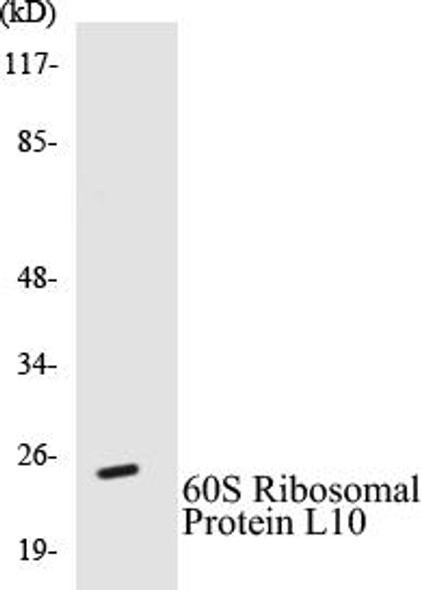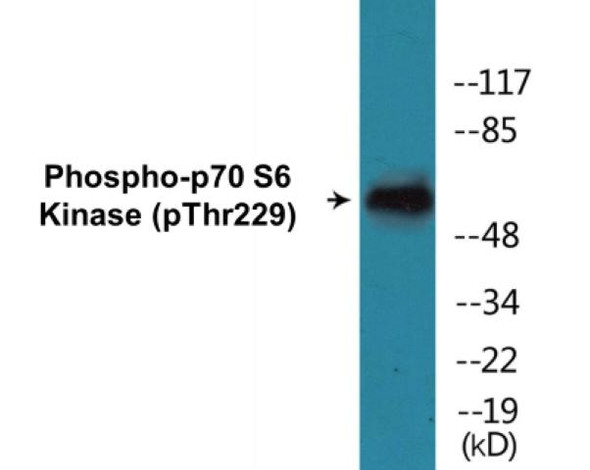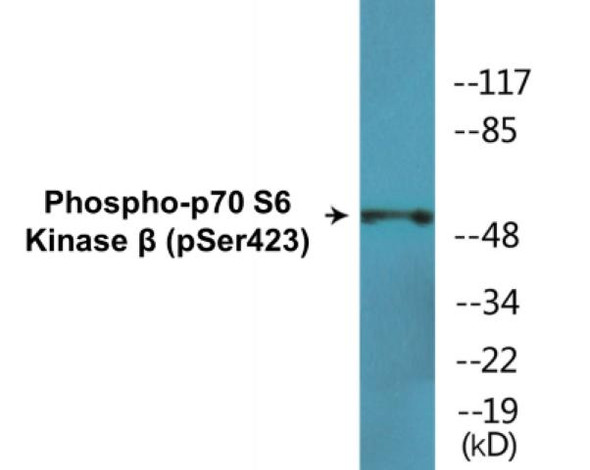S6 Ribosomal Protein (Phospho-Ser240) Colorimetric Cell-Based ELISA Kit
- SKU:
- CBCAB01317
- Product Type:
- ELISA Kit
- ELISA Type:
- Cell Based Phospho Specific
- Reactivity:
- Human
- Mouse
- Rat
- Detection Method:
- Colorimetric
Description
S6 Ribosomal Protein (Phospho-Ser240)Colorimetric Cell-Based ELISA Kit
The S6 Ribosomal Protein Phospho Ser240 Colorimetric Cell-Based ELISA Kit is a powerful tool designed to accurately measure the levels of phosphorylated S6 ribosomal protein at serine 240 in cell lysates. This kit boasts high sensitivity and specificity, allowing for precise and reliable results for a variety of research applications.Phosphorylation of S6 ribosomal protein at serine 240 plays a crucial role in regulating protein synthesis, cell growth, and proliferation. Dysregulation of this pathway has been linked to various diseases, including cancer and metabolic disorders, making it a valuable biomarker for studying these conditions and potentially developing therapeutic interventions.
With easy-to-follow protocols and a user-friendly format, the S6 Ribosomal Protein Phospho Ser240 Colorimetric Cell-Based ELISA Kit is an essential tool for researchers looking to explore the intricate mechanisms behind cell signaling pathways and their implications in disease progression.
| Product Name: | S6 Ribosomal Protein (Phospho-Ser240) Colorimetric Cell-Based ELISA |
| Product Code: | CBCAB01317 |
| ELISA Type: | Cell-Based |
| Target: | S6 Ribosomal Protein (Phospho-Ser240) |
| Reactivity: | Human, Mouse, Rat |
| Dynamic Range: | > 5000 Cells |
| Detection Method: | Colorimetric 450 nm |
| Format: | 2 x 96-Well Microplates |
The S6 Ribosomal Protein (Phospho-Ser240) Colorimetric Cell-Based ELISA Kit is a convenient, lysate-free, high throughput and sensitive assay kit that can detect S6 Ribosomal Protein protein phosphorylation and expression profile in cells. The kit can be used for measuring the relative amounts of phosphorylated S6 Ribosomal Protein in cultured cells as well as screening for the effects that various treatments, inhibitors (ie. siRNA or chemicals), or activators have on S6 Ribosomal Protein phosphorylation.
Qualitative determination of S6 Ribosomal Protein (Phospho-Ser240) concentration is achieved by an indirect ELISA format. In essence, S6 Ribosomal Protein (Phospho-Ser240) is captured by S6 Ribosomal Protein (Phospho-Ser240)-specific primary (1ø) antibodies while the HRP-conjugated secondary (2ø) antibodies bind the Fc region of the 1ø antibody. Through this binding, the HRP enzyme conjugated to the 2ø antibody can catalyze a colorimetric reaction upon substrate addition. Due to the qualitative nature of the Cell-Based ELISA, multiple normalization methods are needed:
| 1. | A monoclonal antibody specific for human GAPDH is included to serve as an internal positive control in normalizing the target absorbance values. |
| 2. | Following the colorimetric measurement of HRP activity via substrate addition, the Crystal Violet whole-cell staining method may be used to determine cell density. After staining, the results can be analysed by normalizing the absorbance values to cell amounts, by which the plating difference can be adjusted. |
| Database Information: | Gene ID: 6194, UniProt ID: P62753, OMIM: 180460, Unigene: Hs.408073 |
| Gene Symbol: | RPS6 |
| Sub Type: | Phospho |
| UniProt Protein Function: | S6: May play an important role in controlling cell growth and proliferation through the selective translation of particular classes of mRNA. Belongs to the ribosomal protein S6e family. |
| UniProt Protein Details: | Protein type:Translation Chromosomal Location of Human Ortholog: 9p21 Cellular Component: polysome; small ribosomal subunit; membrane; perinuclear region of cytoplasm; dendrite; cytoplasm; nucleolus; nucleus; ribonucleoprotein complex; cytosol Molecular Function:protein binding; structural constituent of ribosome; protein kinase binding Biological Process: SRP-dependent cotranslational protein targeting to membrane; erythrocyte development; TOR signaling pathway; viral reproduction; translation; positive regulation of apoptosis; T cell differentiation in the thymus; gastrulation; translational termination; viral infectious cycle; glucose homeostasis; oogenesis stage; T cell proliferation during immune response; translational initiation; ribosomal small subunit assembly and maintenance; viral transcription; activated T cell apoptosis; placenta development; mitosis; mitotic cell cycle checkpoint; ribosomal small subunit biogenesis and assembly; translational elongation; cellular protein metabolic process; insulin receptor signaling pathway; mRNA catabolic process, nonsense-mediated decay; gene expression; rRNA processing; G1/S transition of mitotic cell cycle; negative regulation of apoptosis |
| NCBI Summary: | Ribosomes, the organelles that catalyze protein synthesis, consist of a small 40S subunit and a large 60S subunit. Together these subunits are composed of 4 RNA species and approximately 80 structurally distinct proteins. This gene encodes a cytoplasmic ribosomal protein that is a component of the 40S subunit. The protein belongs to the S6E family of ribosomal proteins. It is the major substrate of protein kinases in the ribosome, with subsets of five C-terminal serine residues phosphorylated by different protein kinases. Phosphorylation is induced by a wide range of stimuli, including growth factors, tumor-promoting agents, and mitogens. Dephosphorylation occurs at growth arrest. The protein may contribute to the control of cell growth and proliferation through the selective translation of particular classes of mRNA. As is typical for genes encoding ribosomal proteins, there are multiple processed pseudogenes of this gene dispersed through the genome. [provided by RefSeq, Jul 2008] |
| UniProt Code: | P62753 |
| NCBI GenInfo Identifier: | 51338632 |
| NCBI Gene ID: | 6194 |
| NCBI Accession: | P62753.1 |
| UniProt Secondary Accession: | P62753,P08227, P10660, Q4VBY7, Q8N6Z7, |
| UniProt Related Accession: | P62753 |
| Molecular Weight: | 249 |
| NCBI Full Name: | 40S ribosomal protein S6 |
| NCBI Synonym Full Names: | ribosomal protein S6 |
| NCBI Official Symbol: | RPS6 |
| NCBI Official Synonym Symbols: | S6 |
| NCBI Protein Information: | 40S ribosomal protein S6; phosphoprotein NP33 |
| UniProt Protein Name: | 40S ribosomal protein S6 |
| UniProt Synonym Protein Names: | Phosphoprotein NP33 |
| Protein Family: | 30S ribosomal protein |
| UniProt Gene Name: | RPS6 |
| UniProt Entry Name: | RS6_HUMAN |
| Component | Quantity |
| 96-Well Cell Culture Clear-Bottom Microplate | 2 plates |
| 10X TBS | 24 mL |
| Quenching Buffer | 24 mL |
| Blocking Buffer | 50 mL |
| 15X Wash Buffer | 50 mL |
| Primary Antibody Diluent | 12 mL |
| 100x Anti-Phospho Target Antibody | 60 µL |
| 100x Anti-Target Antibody | 60 µL |
| Anti-GAPDH Antibody | 60 µL |
| HRP-Conjugated Anti-Rabbit IgG Antibody | 12 mL |
| HRP-Conjugated Anti-Mouse IgG Antibody | 12 mL |
| SDS Solution | 12 mL |
| Stop Solution | 24 mL |
| Ready-to-Use Substrate | 12 mL |
| Crystal Violet Solution | 12 mL |
| Adhesive Plate Seals | 2 seals |
The following materials and/or equipment are NOT provided in this kit but are necessary to successfully conduct the experiment:
- Microplate reader able to measure absorbance at 450 nm and/or 595 nm for Crystal Violet Cell Staining (Optional)
- Micropipettes with capability of measuring volumes ranging from 1 µL to 1 ml
- 37% formaldehyde (Sigma Cat# F-8775) or formaldehyde from other sources
- Squirt bottle, manifold dispenser, multichannel pipette reservoir or automated microplate washer
- Graph paper or computer software capable of generating or displaying logarithmic functions
- Absorbent papers or vacuum aspirator
- Test tubes or microfuge tubes capable of storing ≥1 ml
- Poly-L-Lysine (Sigma Cat# P4832 for suspension cells)
- Orbital shaker (optional)
- Deionized or sterile water
*Note: Protocols are specific to each batch/lot. For the correct instructions please follow the protocol included in your kit.
| Step | Procedure |
| 1. | Seed 200 µL of 20,000 adherent cells in culture medium in each well of a 96-well plate. The plates included in the kit are sterile and treated for cell culture. For suspension cells and loosely attached cells, coat the plates with 100 µL of 10 µg/ml Poly-L-Lysine (not included) to each well of a 96-well plate for 30 minutes at 37 °C prior to adding cells. |
| 2. | Incubate the cells for overnight at 37 °C, 5% CO2. |
| 3. | Treat the cells as desired. |
| 4. | Remove the cell culture medium and rinse with 200 µL of 1x TBS, twice. |
| 5. | Fix the cells by incubating with 100 µL of Fixing Solution for 20 minutes at room temperature. The 4% formaldehyde is used for adherent cells and 8% formaldehyde is used for suspension cells and loosely attached cells. |
| 6. | Remove the Fixing Solution and wash the plate 3 times with 200 µL 1x Wash Buffer for five minutes each time with gentle shaking on the orbital shaker. The plate can be stored at 4 °C for a week. |
| 7. | Add 100 µL of Quenching Buffer and incubate for 20 minutes at room temperature. |
| 8. | Wash the plate 3 times with 1x Wash Buffer for 5 minutes each time. |
| 9. | Add 200 µL of Blocking Buffer and incubate for 1 hour at room temperature. |
| 10. | Wash 3 times with 200 µL of 1x Wash Buffer for 5 minutes each time. |
| 11. | Add 50 µL of 1x primary antibodies Anti-S6 Ribosomal Protein (Phospho-Ser240) Antibody, Anti-S6 Ribosomal Protein Antibody and/or Anti-GAPDH Antibody) to the corresponding wells, cover with Parafilm and incubate for 16 hours (overnight) at 4 °C. If the target expression is known to be high, incubate for 2 hours at room temperature. |
| 12. | Wash 3 times with 200 µL of 1x Wash Buffer for 5 minutes each time. |
| 13. | Add 50 µL of 1x secondary antibodies (HRP-Conjugated AntiRabbit IgG Antibody or HRP-Conjugated Anti-Mouse IgG Antibody) to corresponding wells and incubate for 1.5 hours at room temperature. |
| 14. | Wash 3 times with 200 µL of 1x Wash Buffer for 5 minutes each time. |
| 15. | Add 50 µL of Ready-to-Use Substrate to each well and incubate for 30 minutes at room temperature in the dark. |
| 16. | Add 50 µL of Stop Solution to each well and read OD at 450 nm immediately using the microplate reader. |
(Additional Crystal Violet staining may be performed if desired – details of this may be found in the kit technical manual.)










